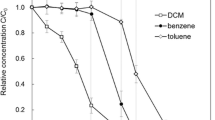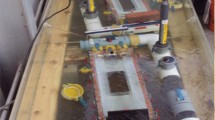Abstract.
Microcosms were inoculated with sediments from both a petroleum-hydrocarbon (PHC)-contaminated aquifer and from a nearby pristine aquifer and incubated under anoxic denitrifying conditions with [methyl-13C]toluene. These microcosms served as a laboratory model system to evaluate the combination of isotope (13C-labeling of polar-lipid-derived fatty acids) and molecular techniques (16S rRNA-targeting gene probes) to identify the toluene-metabolizing population. After total depletion of toluene, the following bacterial phospholipid fatty acids (PLFA) were 13C-enriched: 16:1ω7c, 16:1ω7t, 16:0, cy17:0, and 18:1ω7c. Pure culture experiments demonstrated that these compounds were also found in PLFA profiles of PHC-degrading Azoarcus spp. (β-Proteobacteria) and related species. The origin of the CO2 evolved in the microcosms was determined by measurements of stable carbon isotope ratios. Toluene represented 11% of the total pool of mineralized substrates in the contaminated sediment and 54% in the pristine sediment. The microbial community in the microcosm incubations was characterized by using DAPI staining and whole-cell hybridization with specific fluorescently labeled 16S rRNA-targeted oligonucleotide probes. Results revealed that 6% of the DAPI-stained cells in the contaminated sediment and 32% in the pristine sediment were PHC-degrading Azoarcus spp. In biotic control microcosms (incubated under denitrifying conditions, no toluene added), Azoarcus spp. cells remained at less than 1% of the DAPI-stained cells. The results show that isotope analysis in combination with whole-cell hybridization is a promising approach to identify and to quantify denitrifying toluene degraders within microbial communities.
Similar content being viewed by others
Author information
Authors and Affiliations
Additional information
Electronic Publication
Rights and permissions
About this article
Cite this article
Pelz, O., Chatzinotas, A., Andersen, N. et al. Use of isotopic and molecular techniques to link toluene degradation in denitrifying aquifer microcosms to specific microbial populations. Arch Microbiol 175, 270–281 (2001). https://doi.org/10.1007/s002030100259
Received:
Revised:
Accepted:
Issue Date:
DOI: https://doi.org/10.1007/s002030100259




